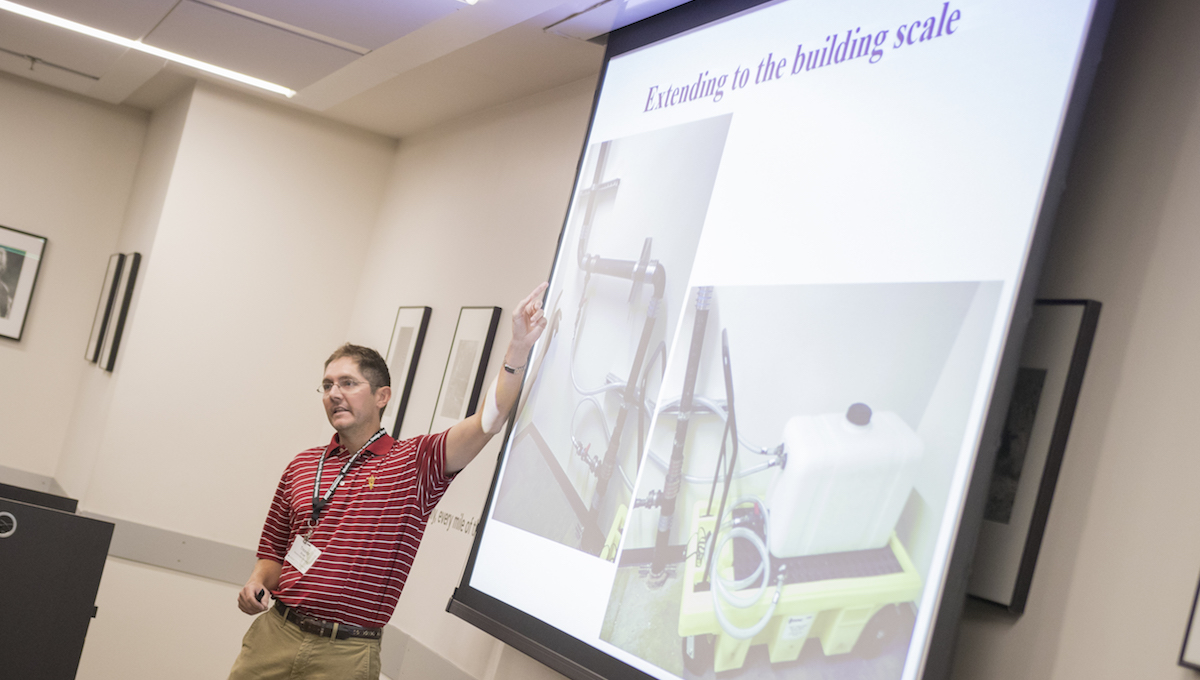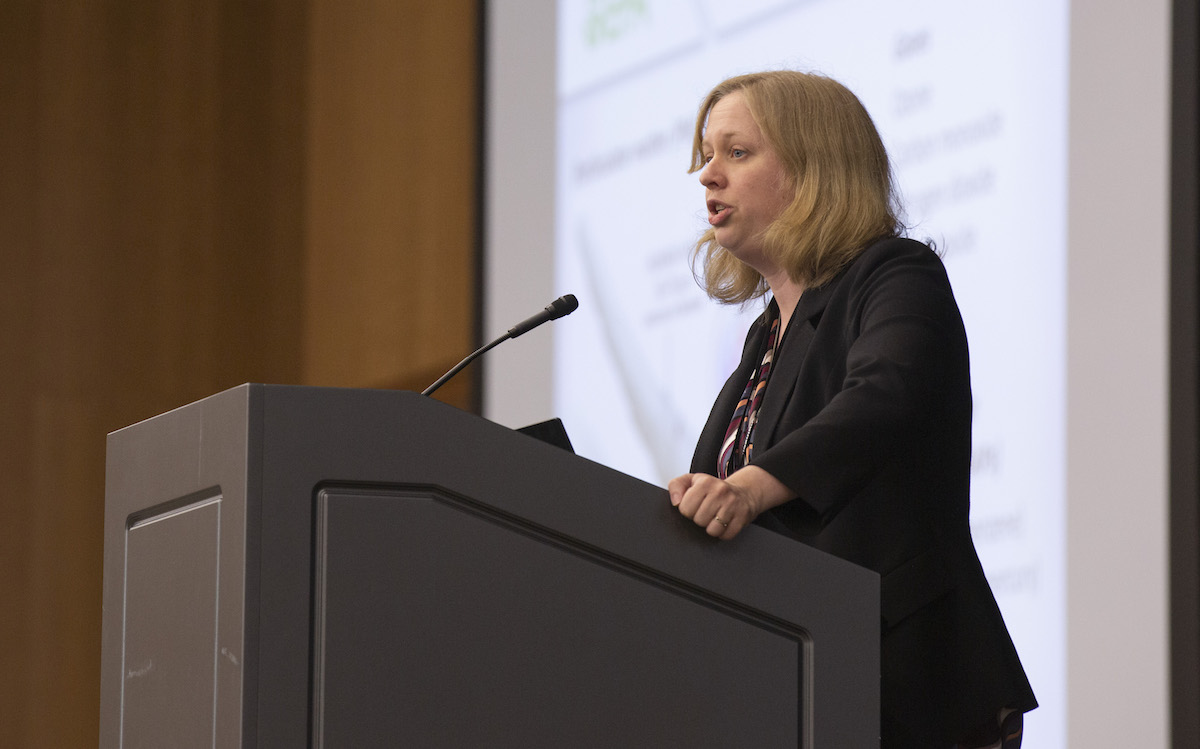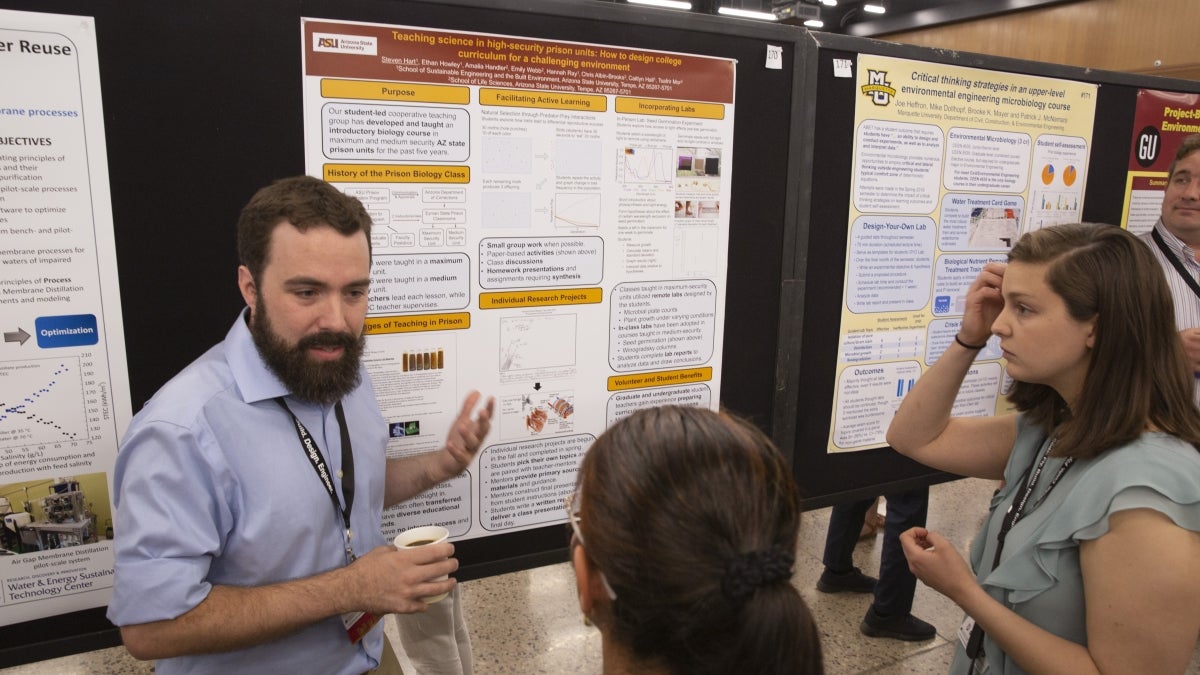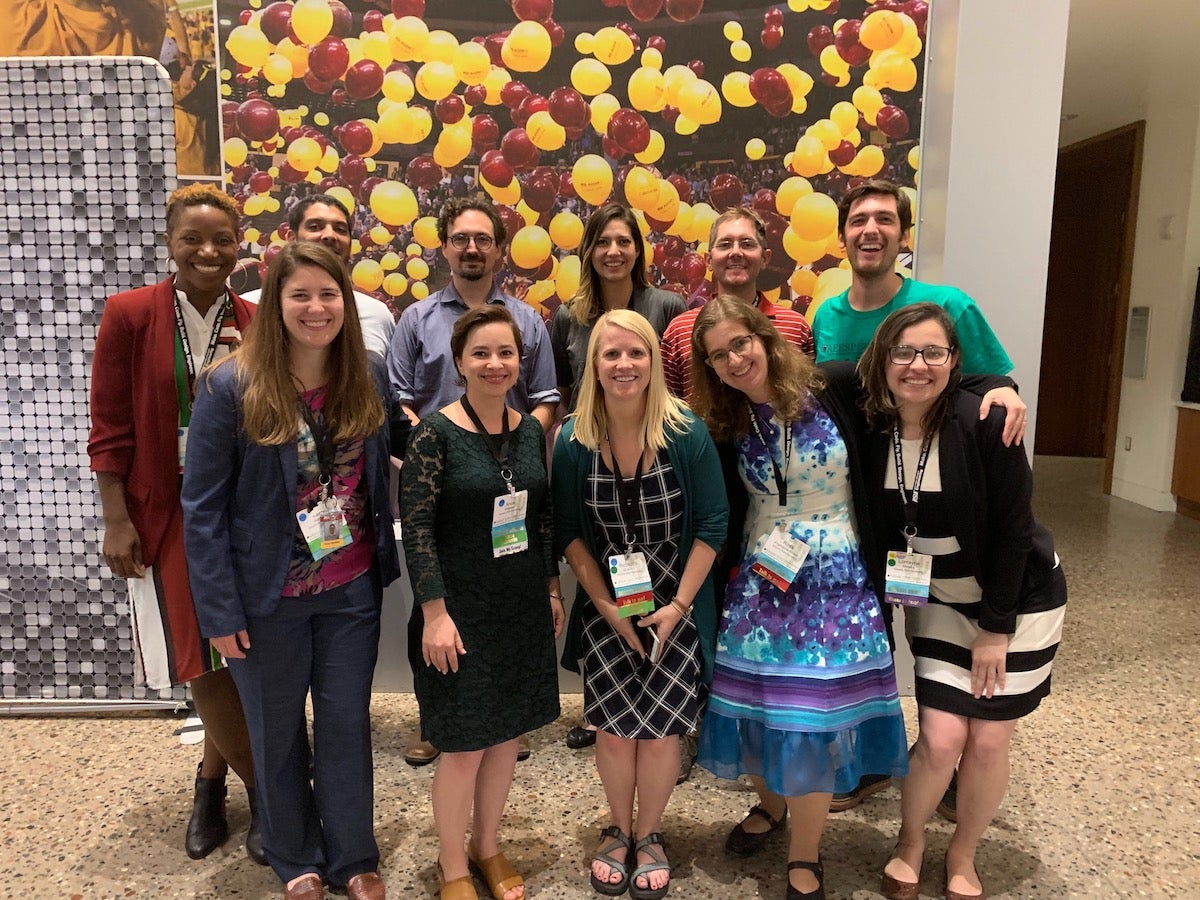Climate change and water scarcity are looming. Dead zones in the oceans are growing. Ecosystems are eroding.
Cities stressed by growth need designs for more resilient infrastructure. Pollutants and contaminants continue to be threats on land, in rivers and streams and in the atmosphere.
These are only some of the global-scale problems keeping environmental engineers and scientists busy trying to find solutions.
So there was more than enough to fuel discussions, presentations and networking during the three-day Association of Environmental Engineering and Science Professors Research and Education Conference at Arizona State University this spring.
Approximately 700 attendees from more than 100 institutions across the world were at the May 14-16 event hosted and organized by faculty in the School of Sustainable Engineering and the Built Environment, one of the six Ira A. Fulton Schools of Engineering at ASU.
The conference theme, “Environmental engineers and scientists see cities in 4D,” set the agenda for examining environment-related issues in four specific dimensions: the built environment, the natural environment, human health and cyberspace.

ASU Associate Professor Treavor Boyer presents one of the engineering technical sessions at the AEESP conference. Boyer chaired the conference, which attracted about 700 attendees from more than 100 academic and research institutions. Photo by Marco-Alexis Chaira/ASU
Current advances and aspirations for the future
The Fulton Schools’ strengths in interdisciplinary research and education in each of those areas played a big role in the AEESP’s decision to hold the conference at ASU, says Treavor Boyer, a Fulton Schools associate professor of environmental engineering and the conference chair.
“It was important to me that the conference themes capture the current state of environmental engineering and also look toward the future,” Boyer says.
The conference’s focus on cities was derived from the mission and goals spelled out in the ASU charter, Boyer says, specifically the directive to “leverage our place,” which includes working with communities to co-develop solutions to social, technical, cultural and environmental issues.
Solutions for cities “are where a lot of our environmental and civil engineers focus their efforts,” he says. “So, along with ASU being in a large metropolitan area, urban environmental solutions made sense as a major emphasis for the conference.”
“Sustainable development and environmental preservation are at the core of much of what we do,” says Professor Ram Pendyala, interim director of the School of Sustainable Engineering and the Built Environment. “The conference provided an excellent venue to showcase the innovative work being done by our faculty and our students.”
New perspectives on problems and solutions
Fulton Schools faculty members were among the event’s featured speakers who reinforced the “4D” theme, giving global perspectives on the specific topics they addressed.
ASU Regents Professor Bruce Rittmann highlighted new directions researchers are turning to in response to challenges in the built-environment sphere.
“We are beginning to change our view of the things that we’ve been calling waste and that we have looked at as liabilities. Now we are working on turning those things into resources with value,” Rittmann says.
“A pollutant is a pollutant often because it’s a resource in the wrong place. For instance, much energy is embedded in the carbon in domestic wastewater, in food waste and animal waste,” he explains. “We need to be using anaerobic microbiological systems to extract that energy. Fortunately, we are now seeing technological advances that can make this a reality.”
Input from Fulton Schools Professors Morteza Abbaszadegan and Rosa Krajmalnik-Brown and Assistant Professor Kerry Hamilton, who all served on the conference planning committee, helped to ensure the event included overviews of what environmental engineers are doing to better protect human health.
Conference attendees heard about research on the threats of infection posed by “opportunistic” pathogens in building plumbing systems, growing antibiotic resistance to medicines and the use of “microbial communities” to fight illnesses and treat conditions such as autism.
Discussions on the cyberspace dimension reflected the emerging role of sensing, data analytics and the "internet of things" in being applied to solving environmental problems. Engineers and scientists are, for instance, increasingly using data-driven approaches to urban water management and employing machine learning to better understand environmental processes, Boyer says.
ASU President’s Professor Brad Allenby talked about engineering education challenges — particularly how to make it more accessible, innovative and relevant.
Allenby pointed to ASU as an example of how those goals are being accomplished to a significant degree by “the breadth of experimentation in teaching and learning methods” at the university.
He says such experiments have fostered an administrative infrastructure that supports faculty in pursuing development of alternative education delivery methods — from new iterations of conventional on-campus classes to a variety of approaches to delivering online courses and degree programs.
There is still a need for better metrics to assess the effectiveness of new course-delivery methods and how to adapt teaching and learning methods to students from countries that have diverse cultural traditions and different approaches to education, Allenby says.
Fulton Schools faculty members who served on the conference organizing committee ensured the event gave attention to a wide range of engineering concerns, from challenges in areas of the built environment and the natural environment to human health and education of the next generation of leaders in the field. Photo courtesy of the School of Sustainable Engineering and the Built Environment
Showcasing the value of environmental engineering
Assistant Professor Rebecca Muenich served on the conference organizing committee and found it “an enriching experience” to participate in setting “the direction and tone of the event.”
Muenich’s contribution was reflected in a focus on developing new solutions for protecting and enhancing the natural environment, especially methods to improve soils, reuse wastewater, ensure safe water supplies and clean up environmental contamination.
The AEESP conference “was just big enough to be able to immerse yourself in the diversity of environmental engineering and just small enough to allow for fruitful networking,” she says. “I had the opportunity to interact with top researchers and to meet students who are going to be our field’s future leaders.”
“This conference significantly elevated the conversation” on each of its guiding themes, Pendyala says. “Treavor Boyer and his organizing team have set a very high bar for future events.”
AEESP’s President-Elect Karl Linden agreed.
“In addition to all the great technical talks and networking, the conference really felt like a celebration of our environmental engineering and science community,” says Linden, a professor of environmental engineering and the Mortenson Professor in Sustainable Development, Civil, Environmental, and Architectural Engineering at the University of Colorado Boulder.
“Innovations in research and teaching, our diversity and inclusivity and the challenges we are taking on, all were evident” at the event, Linden says. “It was also a really great showcase for how ASU is embracing and promoting the value of environmental engineering as an academic discipline and being very successful at it.”

Engineer Gayle Hagler gives a plenary talk at the AEESP conference on the increasing use of cyberspace technology to develop solutions to environmental engineering challenges. Hagler was among U.S. Environmental Protection Agency officials at the event. Photo by Erika Gronek/ASU
Setting the stage for lasting impacts
AEESP President and University of South Florida Professor Maya Trotz says the conference helped raise awareness of the report, “Environmental Engineering for the 21st Century: Addressing Grand Challenges (2019),” recently released by the National Academies of Sciences, Engineering, and Medicine — and emphasized its importance to support for the field from the director of the National Science Foundation’s Environmental Engineering and Sustainability Cluster.
Equally as important, Trotz says, the event enabled attendees to engage productively with each other on “how to actually address our challenges, especially those related to preparing the students in our field.”
Boyer says being the conference chair was the biggest test of his organization and management skills, requiring him “to think through the smallest of details” necessary to coordinate arrangements with a large number of people.
“Essentially, everything happened as planned and all the activities accomplished their intended purpose,” Boyer says. And he is particularly satisfied that the event projected “an overarching vision (through the 4D themes) that connected everything.”
For those who weren’t able to experience in person how ASU is leveraging its place, Boyer is also glad his planning team decided to record much of the event’s proceedings.
“I expect that to help the conference have a more lasting impact,” he says.
Fulton Schools civil, environmental and sustainable engineering doctoral student Daniella Saetta and postdoctoral researcher Ariel Atkinson developed Chats in 4D, which provides videos of many of the AEESP conference presentations, plenary talks, technical sessions and informal discussions. Chats in 4D is posted on the conference website.
Top photo: Steven Hart (left), a civil, environmental and sustainable engineering doctoral student, was among Ira A. Fulton Schools of Engineering students who answered questions about their projects during a research poster presentation session at the recent Environmental Engineering and Science Professors Research and Education Conference at Arizona State University. Faculty members in the School of Sustainable Engineering and the Built Environment, one of the six Fulton Schools at ASU, hosted and organized the event focused on exploring potential remedies to many of the world’s most pressing environmental problems. Photographer: Erika Gronek/ASU/ASU
More Science and technology

Indigenous geneticists build unprecedented research community at ASU
When Krystal Tsosie (Diné) was an undergraduate at Arizona State University, there were no Indigenous faculty she could look to in any science department. In 2022, after getting her PhD in genomics…

Pioneering professor of cultural evolution pens essays for leading academic journals
When Robert Boyd wrote his 1985 book “Culture and the Evolutionary Process,” cultural evolution was not considered a true scientific topic. But over the past half-century, human culture and cultural…

Lucy's lasting legacy: Donald Johanson reflects on the discovery of a lifetime
Fifty years ago, in the dusty hills of Hadar, Ethiopia, a young paleoanthropologist, Donald Johanson, discovered what would become one of the most famous fossil skeletons of our lifetime — the 3.2…

